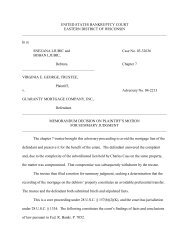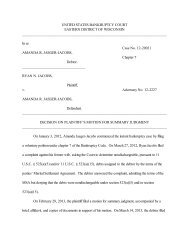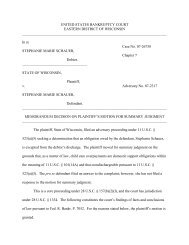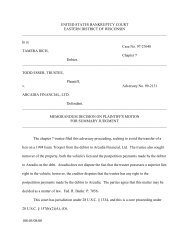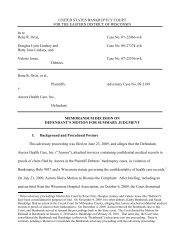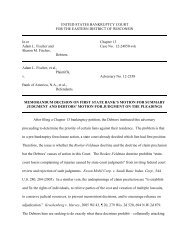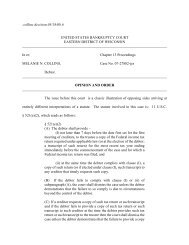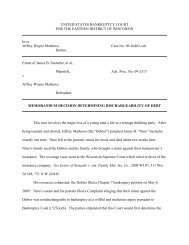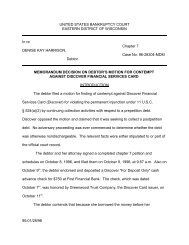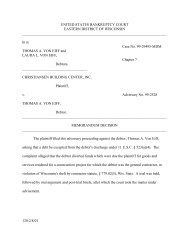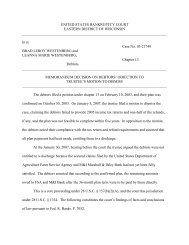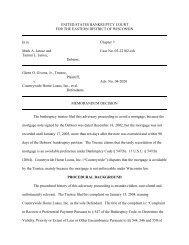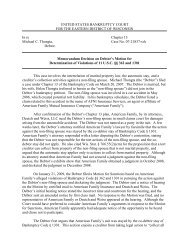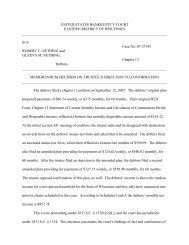Rinaldi v. HSBC Bank USA, N.A. - Eastern District of Wisconsin
Rinaldi v. HSBC Bank USA, N.A. - Eastern District of Wisconsin
Rinaldi v. HSBC Bank USA, N.A. - Eastern District of Wisconsin
You also want an ePaper? Increase the reach of your titles
YUMPU automatically turns print PDFs into web optimized ePapers that Google loves.
UNITED STATES BANKRUPTCY COURTFOR THE EASTERN DISTRICT OF WISCONSINIn re Chapter 13Roger Peter <strong>Rinaldi</strong> andCase No. 11-35689-svkDesa Lilly <strong>Rinaldi</strong>,Debtors.Roger Peter <strong>Rinaldi</strong>, et al.,Plaintiffs,v. Adversary No. 12-2412<strong>HSBC</strong> <strong>Bank</strong> <strong>USA</strong>, N.A., as Trustee, et al.,Defendants.PROPOSED FINDINGS OF FACT AND CONCLUSIONS OF LAW ANDMEMORANDUM DECISION ON DEFENDANTS’ MOTIONS TO DISMISSCOMPLAINT AND AMENDED COMPLAINTRoger <strong>Rinaldi</strong> (“Mr. <strong>Rinaldi</strong>”) and Desa <strong>Rinaldi</strong> (with Mr. <strong>Rinaldi</strong>, the “Debtors”) filedthis adversary proceeding contending that certain mortgage lenders and their lawyers engaged ina “criminogenic scheme” to defraud investors in a securitized trust and seize the Debtors’residence. (Complaint, 77). The defendants moved to dismiss the Debtors’ complaint andamended complaint, and the parties filed briefs. After considering the arguments presented, themotions to dismiss are granted. This Memorandum Decision constitutes the Court’s findings <strong>of</strong>fact and conclusions <strong>of</strong> law. The Court lacks authority to enter a final order on some <strong>of</strong> theclaims, and, accordingly, this decision constitutes proposed findings and conclusions forconsideration by the district court on those claims.Case 12-02412-svk Doc 79 Filed 02/22/13 Page 1 <strong>of</strong> 33
I. THE LOAN TRANSACTION AND STATE COURT LITIGATIONMr. <strong>Rinaldi</strong> signed an Adjustable Rate Note dated June 10, 2005 (the “Note”) in favor <strong>of</strong>Wells Fargo <strong>Bank</strong>, N.A. (Id., Exhibit A). Mr. <strong>Rinaldi</strong> acknowledged that Wells Fargo couldtransfer the Note, and he agreed to pay the Note Holder. (Id.). To secure the Note, the Debtorsexecuted a mortgage dated June 10, 2005 (the “Mortgage”), on their residence located in Bristol,<strong>Wisconsin</strong> (the “property”). (Id., Exhibit B). The mortgagee is Wells Fargo <strong>Bank</strong>, N.A. Thecopy <strong>of</strong> the Note filed in the bankruptcy case is stamped with an undated endorsement signed byJoan M. Mills, as Vice President <strong>of</strong> Wells Fargo <strong>Bank</strong>, N.A.: “Without Recourse Pay to theOrder <strong>of</strong> (blank).” (Id., Exhibit G).The Debtors defaulted on the Note, and on February 3, 2009, <strong>HSBC</strong> <strong>Bank</strong> <strong>USA</strong>, NationalAssociation (“<strong>HSBC</strong>”), as Trustee for Wells Fargo Asset Securities Corporation Home EquityAsset-Backed Certificates, Series 2005-2, started an action against the Debtors in the CircuitCourt for Kenosha County to foreclose the property. (Affidavit <strong>of</strong> Stephanie L. Dykeman insupport <strong>of</strong> <strong>HSBC</strong>’s motion to dismiss, Docket No. 41 (“Dykeman Aff.”), Exhibit J). In theiranswer to the foreclosure complaint, among other defenses, the Debtors disputed <strong>HSBC</strong>’sstanding to enforce or collect on the Note, “unless it can be proved that the proper assignmentsand allonges are present with the original note . . . .” (Id., Exhibit E, 1). The Debtors alsoclaimed that there were irregularities in the initiation <strong>of</strong> the Mortgage transaction, includingalteration <strong>of</strong> the Debtors’ loan application. (Id., Exhibit E, 17-20). After considering theDebtors’ claims and defenses, the state court granted <strong>HSBC</strong>’s motion for summary judgment andentered a foreclosure judgment in <strong>HSBC</strong>’s favor on January 26, 2010. (Id., Exhibit B). TheDebtors did not appeal the judgment <strong>of</strong> foreclosure. On November 12, 2010, the Debtors filed amotion to obtain relief from the foreclosure judgment, and on November 22, 2010, they filed a2Case 12-02412-svk Doc 79 Filed 02/22/13 Page 2 <strong>of</strong> 33
ief in support <strong>of</strong> their motion to vacate the judgment. (Id., Exhibit G). On January 6, 2011, theCircuit Court for Kenosha County denied the Debtors’ motion to vacate the foreclosurejudgment, specifically finding that the affidavits in support <strong>of</strong> summary judgment were notfraudulent. (Id., Exhibit D).Despite the contentious proceedings in the Kenosha County Circuit Court, <strong>HSBC</strong> and theDebtors negotiated and agreed upon a loan modification. As a result, on January 18, 2011, thestate court granted <strong>HSBC</strong>’s petition for dismissal <strong>of</strong> the foreclosure action and vacated theforeclosure judgment. (Id., Exhibit G). The litigation honeymoon was short-lived. On June 10,2011, the Debtors filed suit in the Circuit Court for Kenosha County against Wells Fargo <strong>Bank</strong>,<strong>HSBC</strong> and their lawyers, Gray & Associates, LLP. The Debtors’ claims mirrored the claims andcounterclaims that the Circuit Court had dismissed in the foreclosure action. (Id., Exhibit H.)II.BANKRUPTCY PROCEEDINGSOn October 14, 2011, the Debtors filed a Chapter 7 petition in this Court. On March 21,2012, on the Debtors’ motion, the Court converted the Debtors’ case to Chapter 13. On June 14,2012, the Debtors filed an objection to <strong>HSBC</strong>’s pro<strong>of</strong> <strong>of</strong> claim, and on June 17, 2012, theDebtors filed this adversary proceeding against <strong>HSBC</strong>, as Trustee, Wells Fargo <strong>Bank</strong>, N.A.,Wells Fargo Asset Securities Corporation, Wells Fargo <strong>Bank</strong>, N.A. d/b/a America’s ServicingCompany, Litchfield Cavo, LLP, Brad A. Markvart (collectively the “Wells Defendants”), Gray& Associates, LLP, William N. Foshag, Duncan C. Delhey, Jay Pitner and Brian D. Perhach(collectively, the “Gray Defendants”).On June 28, 2012, <strong>HSBC</strong> filed a motion for relief from stay, and on August 9, 2012,<strong>HSBC</strong> filed an objection to confirmation <strong>of</strong> the Debtors’ Chapter 13 plan, which proposed totreat <strong>HSBC</strong>’s claim as unsecured. On July 12, 2012, the Debtors filed a motion to disqualify3Case 12-02412-svk Doc 79 Filed 02/22/13 Page 3 <strong>of</strong> 33
III. RELIEF SOUGHT IN THE COMPLAINT AND AMENDED COMPLAINTInitially, the Debtors ask the Court to determine the validity and enforceability <strong>of</strong><strong>HSBC</strong>’s pro<strong>of</strong> <strong>of</strong> claim. The Debtors’ objections to the claim include that the Note lacksconsideration; two mortgage assignments are null and void; another mortgage assignment is aforgery or unenforceable because it was not recorded or perfected prior to bankruptcy; <strong>HSBC</strong> isnot the owner or holder <strong>of</strong> the Note; and the Note image attached to the claim was fabricated todeceive the Court. Along with disallowance <strong>of</strong> the claim and the security represented by theMortgage, the Debtors seek a determination that the pro<strong>of</strong> <strong>of</strong> claim is false, fraudulent andunlawful. The Debtors ask the Court to determine that none <strong>of</strong> the Wells Defendants hasstanding or the status <strong>of</strong> real party in interest to maintain a claim for relief from stay.The Debtors also accuse the Gray Defendants <strong>of</strong> common law fraud, abuse <strong>of</strong> legalprocess and violations <strong>of</strong> the Fair Debt Collections Practices Act (“FDCPA”). The Debtorsaccuse the Wells Defendants <strong>of</strong> the same, and the amended complaint added a claim for damagesfor violations <strong>of</strong> the Racketeer Influenced and Corrupt Organizations Act (“RICO”).Specifically against Wells Fargo <strong>Bank</strong>, N. A., the Debtors assert claims for breach <strong>of</strong> contractand tortious interference with prospective economic opportunity.IV.JURISDICTIONA. General <strong>Bank</strong>ruptcy JurisdictionJurisdiction over bankruptcy cases as well as proceedings arising under the <strong>Bank</strong>ruptcyCode and arising in or related to bankruptcy cases resides in the district court. 28 U.S.C. §1334(b). Pursuant to 28 U.S.C. § 157(a), the district court may refer these cases and proceedingsto the bankruptcy judges for the district, and the <strong>District</strong> Court for <strong>Eastern</strong> <strong>District</strong> <strong>Wisconsin</strong>entered a standing order <strong>of</strong> reference dated July 10, 1984 to accomplish this referral. Under 285Case 12-02412-svk Doc 79 Filed 02/22/13 Page 5 <strong>of</strong> 33
U.S.C. § 157(b)(1), bankruptcy judges may hear, determine and enter final orders in all “coreproceedings” arising in a bankruptcy case or arising under the <strong>Bank</strong>ruptcy Code. If a matter isnot a core proceeding, but is related to a bankruptcy case, the bankruptcy judge may hear theproceeding, but must submit proposed findings <strong>of</strong> fact and conclusions <strong>of</strong> law to the district courtfor entry <strong>of</strong> the final order. 28 U.S.C. § 157(c)(1). A list <strong>of</strong> core proceedings is found in 28U.S.C. § 157(b)(2). In Stern v. Marshall, 131 S. Ct. 2594 (2011), the Supreme Court held thateven though a proceeding (a counterclaim to a pro<strong>of</strong> <strong>of</strong> claim) appeared on the list <strong>of</strong> coreproceedings, the bankruptcy judge lacked constitutional authority to enter a final order.Allowance <strong>of</strong> pro<strong>of</strong>s <strong>of</strong> claim falls within the core matters that the bankruptcy court mayhear and determine under 28 U.S.C. § 157(b)(2)(B). Unlike the entry <strong>of</strong> a final order on a statelaw counterclaim, allowance <strong>of</strong> claims was not deemed unconstitutional in Stern. 131 S. Ct. at2614. Stern reaffirmed that bankruptcy courts have the authority to restructure the debtorcreditorrelationship and determine “creditors’ hierarchically ordered claims to a pro rata share <strong>of</strong>the bankruptcy res.” Id.; see also In re Salander O'Reilly Galleries, 453 B.R. 106, 117 (<strong>Bank</strong>r.S.D.N.Y. 2011) (application <strong>of</strong> state law to allow claims properly rests in the bankruptcy court).Thus, the Court has authority to finally determine the validity <strong>of</strong> <strong>HSBC</strong>’s claim.Similarly, under 28 U.S.C. § 157(b)(2)(G) the Court can hear and determine whether<strong>HSBC</strong> has standing to seek relief from the automatic stay, a creature <strong>of</strong> the <strong>Bank</strong>ruptcy Code andfundamental pillar <strong>of</strong> bankruptcy law. Stern, 131 S. Ct. at 2618 (bankruptcy court hasconstitutional authority over claims when “the action at issue stems from the bankruptcy itself”).And, the Court can determine the validity <strong>of</strong> <strong>HSBC</strong>’s mortgage lien on the Debtors’ residence asproperty <strong>of</strong> the bankruptcy estate and as part <strong>of</strong> the claims allowance process. See Pulaski v.Dakota Fin., LLC (In re Pulaski), 475 B.R. 681, 687 (<strong>Bank</strong>r. W.D. Wis. 2012) (“In the present6Case 12-02412-svk Doc 79 Filed 02/22/13 Page 6 <strong>of</strong> 33
830, 839 (3d Cir. 1999)). See also O'Toole v. McTaggart (In re Trinsum Group, Inc.), 467 B.R.734 (<strong>Bank</strong>r. S.D.N.Y. 2012) (addressing the procedure when some, but not all, defendantsconsent to bankruptcy court’s entry <strong>of</strong> final order). Consistent with this approach, this Court willendeavor to separate the core and non-core claims, entering a final order only on the core claims,and making recommendations to the district court on the non-core claims.B. Jurisdictional Issues Created by Rooker-Feldman DoctrineThe Rooker-Feldman doctrine prohibits “state-court losers complaining <strong>of</strong> injuries causedby state-court judgments” from inviting federal court review and rejection <strong>of</strong> such judgments.Exxon Mobil Corp. v. Saudi Basic Indus. Corp., 544 U.S. 280, 284 (2005). The Rooker-Feldmandoctrine is jurisdictional in nature; its applicability must be determined before any otheraffirmative defense, including claim preclusion. Long v. Shorebank Dev. Corp., 182 F.3d 548,554-55 (7th Cir. 1999) (citing Garry v. Geils, 82 F.3d 1362, 1365 (7th Cir. 1996)). “In certaincircumstances, where a federal suit follows a state suit, the Rooker-Feldman doctrine prohibitsthe district court from exercising jurisdiction.” Great Western Mining & Mineral Co. v. FoxRothschild LLP, 615 F.3d 159, 163 (3d Cir. 2010).The Rooker-Feldman analysis applies in bankruptcy court adversary proceedings.Knapper v. <strong>Bank</strong>ers Trust Co. (In re Knapper), 407 F.3d 573, 581 (3d Cir. 2005) (citing Baldinov. Wilson (In re Wilson), 116 F.3d 87 (3d Cir. 1997)). Courts have applied the doctrine to barcollateral attacks on state court foreclosure judgments. Kline v. Deutsche <strong>Bank</strong> Nat’l Trust Co.(In re Kline), 472 B.R. 98, 105 (B.A.P. 10th Cir. 2012). And some courts have dismissed claimssimilar to the Debtors’ claims, based in part on the Rooker-Feldman doctrine. See Washington v.Saxon Mortg. Servs. (In re Washington), 469 B.R. 587, 590 (<strong>Bank</strong>r. W.D. Pa. 2012) (holding thatdebtor did not have standing to challenge mortgage based on pooling and servicing agreement,9Case 12-02412-svk Doc 79 Filed 02/22/13 Page 9 <strong>of</strong> 33
and, if debtor did have standing, claims should have been raised in foreclosure case and werebarred by Rooker-Feldman); Mayeres v. BAC Home Loans, 2011 <strong>Bank</strong>r. LEXIS 2793 (<strong>Bank</strong>r.D.N.J. July 21, 2011) (abstaining based on Rooker-Feldman from debtor’s complaint seekinginvalidation <strong>of</strong> mortgage and disallowance <strong>of</strong> mortgage claim).In assessing the applicability <strong>of</strong> the Rooker-Feldman doctrine, the fundamental questionis “‘whether the injury alleged by the federal plaintiff resulted from the state court judgmentitself or is distinct from that judgment.’” Lewis v. Anderson, 308 F.3d 768, 772 (7th Cir. 2002)(citing Rizzo v. Sheahan, 266 F.3d 705, 713 (7th Cir. 2001)). “[I]f the alleged injury is distinctfrom the state court judgment and not inextricably intertwined with it, the Rooker-Feldmandoctrine does not apply, although the doctrines <strong>of</strong> claim and issue preclusion may be applicable.”Long, 182 F.3d at 555 (quotations and citations omitted).The Debtors’ claims in this adversary proceeding are virtually the same claims theyadvanced in the state court foreclosure action. To the extent the claims are not the same, theyappear to be “inextricably intertwined” with those claims. However, after the state court rejectedthe Debtors’ claims and entered a judgment <strong>of</strong> foreclosure, the Debtors and <strong>HSBC</strong> entered into aloan modification agreement, and the foreclosure judgment was vacated.The defendants argue that the judgment remains viable for preclusion purposes, citingKowske v. Ameriquest Mortg. Co., 2009 WI App 45, 317 Wis. 2d 500, 767 N.W.2d 309. InKowske, a mortgage creditor obtained a default judgment <strong>of</strong> foreclosure. During the redemptionperiod, the debtor sold the property and paid the mortgage, “without ever challenging or movingto set aside the default judgment.” Id. at 22. Upon payment <strong>of</strong> the mortgage, the mortgagecreditor sought and obtained an order vacating the judgment <strong>of</strong> foreclosure and dismissing thecase. Two years later, the debtor sued the mortgage creditor for unfair trade practices and10Case 12-02412-svk Doc 79 Filed 02/22/13 Page 10 <strong>of</strong> 33
alleged misrepresentations during the mortgage application process. The court <strong>of</strong> appeals upheldthe dismissal <strong>of</strong> the debtor’s suit on claim preclusion grounds, holding:[T]he order dismissing the action based on Kowske’s payment <strong>of</strong> the mortgagewas a final judgment on the merits in the foreclosure action. Ameriquest’s actionsto clear the title were based on Kowske’s acceptance <strong>of</strong> the rights Ameriquestestablished in the foreclosure action. The order dismissing the judgment <strong>of</strong>foreclosure was not based on an error in the original judgment <strong>of</strong> foreclosure, butrather on the successful attainment <strong>of</strong> the judgment <strong>of</strong> foreclosure and thesubsequent payment <strong>of</strong> the mortgage by Kowske. That trial court order endedlitigation between the parties concerning the mortgage and foreclosure, andneither party appealed from that order.Id. at 24.This case is different. Rather than a payment and satisfaction <strong>of</strong> the mortgage, theDebtors and <strong>HSBC</strong> entered into a loan modification agreement, effectuating a settlement <strong>of</strong> theclaims and counterclaims raised in the foreclosure case. The foreclosure judgment was notvacated because the Debtors had paid and satisfied the mortgage, but rather because <strong>HSBC</strong>agreed to reinstate the mortgage debt and accept modified payment terms. The Debtors hadmoved for relief from the foreclosure judgment, and the appeal period on the denial <strong>of</strong> thatmotion had not expired when the parties entered into the loan modification agreement. The orderdismissing the foreclosure action thus did not represent the “successful attainment <strong>of</strong> thejudgment <strong>of</strong> foreclosure,” but rather a settlement under which that judgment was vacated.Although it is arguable that the foreclosure judgment that was later settled and vacated is a finaljudgment for claim preclusion purposes, this Court will assume that the Rooker-Feldmandoctrine does not apply to bar the Court’s exercise <strong>of</strong> jurisdiction under these uniquecircumstances.11Case 12-02412-svk Doc 79 Filed 02/22/13 Page 11 <strong>of</strong> 33
C. Standard on Motion to DismissMotions to dismiss bankruptcy adversary proceedings are governed by <strong>Bank</strong>ruptcy Rule7012, incorporating Federal Rule <strong>of</strong> Civil Procedure 12. Federal courts are familiar with Rule12(b)(6) motions for failure to state a claim upon which relief can be granted. In Brooks v. Ross,578 F.3d 574, 581 (7th Cir. 2009), the court <strong>of</strong> appeals summarized the applicable legalstandards to judge whether a complaint should be dismissed under Rule 12(b)(6): “First, aplaintiff must provide notice to defendants <strong>of</strong> her claims. Second, courts must accept aplaintiff’s factual allegations as true, but some factual allegations will be so sketchy orimplausible that they fail to provide sufficient notice to defendants <strong>of</strong> the plaintiff’s claim.Third, in considering the plaintiff’s factual allegations, courts should not accept as adequateabstract recitations <strong>of</strong> the elements <strong>of</strong> a cause <strong>of</strong> action or conclusory legal statements.”Additionally, since the Debtors allege that the defendants committed fraud, <strong>Bank</strong>ruptcyRule 7009, incorporating Federal Rule <strong>of</strong> Civil Procedure 9(b) requires the Debtors to “state withparticularity the circumstances” constituting the fraud. And, in Swanson v. Citibank, N.A., 614F.3d 400, 406 (7th Cir. 2010), the court <strong>of</strong> appeals noted: “[A] plaintiff must plead actualdamages arising from her reliance on a fraudulent statement.” After applying these standards,the Debtors have failed to state a claim upon which relief can be granted, and their adversaryproceeding should be dismissed.V. ANALYSISA. The Pro<strong>of</strong> <strong>of</strong> Claim and Standing <strong>of</strong> the Wells Defendants to Seek Relief From StayThe Debtors’ amended complaint seeks disallowance <strong>of</strong> <strong>HSBC</strong>’s pro<strong>of</strong> <strong>of</strong> claim onvarious theories that can be crystallized as (1) the Note is invalid; and (2) various assignments <strong>of</strong>12Case 12-02412-svk Doc 79 Filed 02/22/13 Page 12 <strong>of</strong> 33
the Mortgage are invalid. Starting with the Note, some <strong>of</strong> the Debtors’ arguments border onfrivolous, others have more substance, but, in the end, they all fail.1. The Note is Valid and Enforceable by <strong>HSBC</strong>.In the frivolous category, the Debtors contend that neither Wells Fargo nor <strong>HSBC</strong> loanedthe Debtors any money, but rather that the Debtors’ mortgage transaction was part <strong>of</strong> anelaborate scheme to defraud investors in a securitized trust. Due to this duplicitous design, theDebtors conclude that the Note fails for lack <strong>of</strong> consideration. But Mr. <strong>Rinaldi</strong> executed theNote under seal, which is conclusive pro<strong>of</strong> <strong>of</strong> consideration. See Edwards v. Petrone, 160 Wis.2d 255, 258, 465 N.W.2d 847 (Ct. App. 1990) (presence <strong>of</strong> a seal establishes consideration forexecuted contracts).Claiming that the Note’s endorsement is either invalid or fraudulent, the Debtors alsoargue that <strong>HSBC</strong> is neither an owner nor holder <strong>of</strong> the Note. Similar defects in a promissorynote were alleged in Edwards v. Deutsche <strong>Bank</strong> Nat'l Trust Co. (In re Edwards), 2011 <strong>Bank</strong>r.LEXIS 5065 (<strong>Bank</strong>r. E.D. Wis. Dec. 23, 2011). The Edwards court first analyzed whether thepromissory note was a negotiable instrument governed by Article 3 <strong>of</strong> the Uniform CommercialCode. See Wis. Stat. §§ 403.102-.403.605. The court concluded that under the definition <strong>of</strong>negotiable instrument in Wis. Stat. § 403.104(1), there was “no question <strong>of</strong> negotiability” under<strong>Wisconsin</strong> law. Id. at *16. The note “contains the debtor’s written promise to pay a fixedamount <strong>of</strong> money; it is payable at a definite time, that is on a monthly schedule; and the Notedoes not state any other undertaking.” Id. The Note signed by Mr. <strong>Rinaldi</strong> also meets theserequirements.In Edwards, the debtor argued that the pre-payment provisions rendered the note nonnegotiable,but the court rejected the argument. In the end, the court authorized the creditor, as a13Case 12-02412-svk Doc 79 Filed 02/22/13 Page 13 <strong>of</strong> 33
holder <strong>of</strong> the note, to enforce it, despite the debtor’s challenges to the creditor’s signature andendorsements. Apparently the promissory note in Edwards had a fixed interest rate, while theNote in this case has an adjustable interest rate. But Wis. Stat. § 403.112 provides that interestmay be stated as a fixed or variable rate, and that determination <strong>of</strong> the interest rate may includereference to information not contained in the instrument. Accordingly, the adjustable interestrate does not prevent the Note from qualifying as a negotiable instrument. The otherrequirements <strong>of</strong> negotiability are met, and, like in Edwards, the Note is a negotiable instrument,entitled to all the benefits <strong>of</strong> that status under <strong>Wisconsin</strong> law.The Debtors accuse the defendants <strong>of</strong> producing “the forged endorsement to the mortgagenote robo-stamped bearing the signature <strong>of</strong> Joan M. Mills to mislead this court into believing thatthe note had been timely, properly and authentically endorsed in blank after the commencement<strong>of</strong> [the foreclosure action].” (Complaint, 91(b)(6)). First, Mr. <strong>Rinaldi</strong> executed the Note, andhe does not dispute that his signature on the Note is genuine. Ms. Mills’ signature on theendorsement is deemed authentic and not subject to challenge by the Debtors. Edwards, at * 21,citing Wis. Stat. § 403.308(1).Second, the Debtors’ insinuation that Wells Fargo endorsed the Note after the foreclosureproceeding is irrelevant to the determination <strong>of</strong> the validity <strong>of</strong> the pro<strong>of</strong> <strong>of</strong> claim. The copy <strong>of</strong>the Note attached to the pro<strong>of</strong> <strong>of</strong> claim contains the endorsement in blank. There is norequirement that an endorsement be dated. Edwards, at *21-22, citing Wis. Stat. § 403.204(1).As the bearer <strong>of</strong> a note endorsed in blank, <strong>HSBC</strong> is a holder <strong>of</strong> the Note, and <strong>HSBC</strong> is entitled toenforce the Note against Mr. <strong>Rinaldi</strong>. See Wis. Stat. §§ 403.205; 403.301. The Debtorscomplain about the apparent lack <strong>of</strong> the endorsement in the state court foreclosure; but the statecourt was the forum to raise that argument. The issue in this adversary proceeding is the validity14Case 12-02412-svk Doc 79 Filed 02/22/13 Page 14 <strong>of</strong> 33
<strong>of</strong> the pro<strong>of</strong> <strong>of</strong> claim. The Note attached to the claim is endorsed in blank and the Debtors lackstanding to challenge the validity or timing <strong>of</strong> the endorsement. Therefore <strong>HSBC</strong> has standing t<strong>of</strong>ile the claim to enforce the Note.Since Mr. <strong>Rinaldi</strong> executed the Note, a negotiable instrument under <strong>Wisconsin</strong> law, andthe Note was endorsed in blank, <strong>HSBC</strong>, as bearer <strong>of</strong> the Note, is entitled to enforce it against Mr.<strong>Rinaldi</strong>. The Court rejects the Debtors’ arguments about the invalidity <strong>of</strong> the Note, and will notdisallow, deem fraudulent or otherwise invalidate <strong>HSBC</strong>’s pro<strong>of</strong> <strong>of</strong> claim based on thosearguments.2. The Mortgage Assignments do not Invalidate the Pro<strong>of</strong> <strong>of</strong> Claim.The Debtors also attack the mortgage based on faulty assignments and invalid andincomplete transfers to a securitized trust. Arguments based on questionable mortgageassignments also were considered and rejected in Edwards, based on the doctrine <strong>of</strong> “equitableassignment.” Under this common law doctrine, the holder <strong>of</strong> the Note is entitled to enforce themortgage. As the Edwards court explained:This doctrine recognizes that “[t]he note and mortgage are inseparable; the formeras essential, the latter as an incident. An assignment <strong>of</strong> the note carries themortgage with it, while an assignment <strong>of</strong> the latter alone is a nullity.” Carpenterv. Longan, 83 U.S. 271, 274 (1873). The debt is the principal thing, to which thesecurity instrument is an incident there<strong>of</strong>. Cf. Doyon & Rayne Lumber Co. v.Nichols, 196 Wis. 387, 390, 220 N.W. 181 (1928); Mitchell <strong>Bank</strong> v. Schanke,2004 WI 13, 268 Wis. 2d 571, 597, 676 N.W.2d 849, 858. Under this view, longestablished in <strong>Wisconsin</strong> law, the Mortgage is equitably assigned when the Noteis endorsed and negotiated to its current holder.Edwards, at *22-23.Quoting Tidioute Savings <strong>Bank</strong> v. Libbey, 101 Wis. 193, 77 N.W. 182, 183 (1898), thecourt noted that the debtor is not prejudiced by this doctrine because, “He has agreed that the15Case 12-02412-svk Doc 79 Filed 02/22/13 Page 15 <strong>of</strong> 33
security shall stand for the payment <strong>of</strong> the debt, and it is <strong>of</strong> no consequence to him to whom it ispaid. He has to pay it but once.” Edwards, at *24. Under this doctrine, <strong>HSBC</strong>, as transferee <strong>of</strong>the Note, is entitled to enforce the Mortgage.Wells Fargo assigned the Mortgage to <strong>HSBC</strong>. Three assignment documents exist:September 14, 2005 (unrecorded); March 1, 2010 (recorded April 5, 2010); and October 31,2011 (recorded November 1, 2011) (Complaint, Exhibits C, D, E). The Debtors vehementlyprotest the fact that no assignment was recorded until after the foreclosure proceedingcommenced. First, the timing with respect to the foreclosure case is irrelevant to the validity <strong>of</strong><strong>HSBC</strong>’s pro<strong>of</strong> <strong>of</strong> claim in this bankruptcy case. The assignment was executed prior to thebankruptcy petition, and one <strong>of</strong> the assignments was recorded prior to the petition. The Debtorshad the opportunity and indeed raised <strong>HSBC</strong>’s standing in the foreclosure action. If the statecourt had agreed with the Debtors on this issue, the result might have been different and theDebtors could have questioned the pro<strong>of</strong> <strong>of</strong> claim. But the state court entered a judgment <strong>of</strong>foreclosure in favor <strong>of</strong> <strong>HSBC</strong>, and now <strong>HSBC</strong> has filed a pro<strong>of</strong> <strong>of</strong> claim asserting its rights to asecurity interest in the property. <strong>HSBC</strong> is the holder <strong>of</strong> the Note, and is the named assignee <strong>of</strong>the Mortgage according to an attachment to the pro<strong>of</strong> <strong>of</strong> claim. As holder <strong>of</strong> the Note, <strong>HSBC</strong> isentitled to enforce the Mortgage. The Court rejects the Debtors’ arguments that the claim isfraudulent or should be disallowed based on the assignments.Moreover, defects in the transfer <strong>of</strong> the Note to the Wells Fargo Asset SecuritiesCorporation Home Equity Asset-backed Certificates Series 2005-2 Trust (or any similarly namedentity) (the “Trust”) do not render the Mortgage unenforceable, the Note invalid or the pro<strong>of</strong> <strong>of</strong>claim fraudulent. It is well-settled that a borrower lacks standing to challenge the validity <strong>of</strong> aloan assignment based on issues related to a Pooling and Servicing Agreement (“PSA”), because16Case 12-02412-svk Doc 79 Filed 02/22/13 Page 16 <strong>of</strong> 33
a borrower is neither a party to the PSA nor a third party beneficiary. See, e.g., In re Sandford,2012 <strong>Bank</strong>r. LEXIS 5609, *9-10 (<strong>Bank</strong>r. D.N.M. Dec. 3, 2012) (citing numerous cases,including Edwards).Whether due to <strong>HSBC</strong>’s status <strong>of</strong> holder <strong>of</strong> the Note, the doctrine <strong>of</strong> equitable merger, orthe Debtors’ lack <strong>of</strong> standing to challenge the Mortgage due to alleged irregularities in the PSA,the Court concludes that the Mortgage is valid and enforceable by <strong>HSBC</strong>. The Court rejects all<strong>of</strong> the Debtors’ arguments challenging the pro<strong>of</strong> <strong>of</strong> claim due to alleged deficiencies in theassignments or breaches <strong>of</strong> or other matters concerning the PSA or the Trust.3. <strong>HSBC</strong> has Standing to Seek Relief from Stay.The threshold for standing to seek relief from stay is that the moving creditor has a“colorable claim” to property <strong>of</strong> the estate. Grella v. Salem Five Cent Sav. <strong>Bank</strong>, 42 F.3d 26, 33-34 (1st Cir. 1994) (citing In re Vitreous Steel Products Co., 911 F.2d 1223 (7th Cir. 1990)).Hearings on motions for relief from stay are intended to be summary proceedings in which thebankruptcy court decides only a limited set <strong>of</strong> issues: whether the creditor is adequatelyprotected; equity in the property; and necessity <strong>of</strong> the property for reorganization. See 11 U.S.C.§ 362(d). Given these parameters, a bankruptcy court’s decision to modify the stay “is not anadjudication <strong>of</strong> the validity or avoidability <strong>of</strong> the claim, but only a determination that thecreditor’s claim is sufficiently plausible to allow its prosecution elsewhere.” Grella, 42 F.3d at34. Having determined that <strong>HSBC</strong> is the holder <strong>of</strong> the Note, and that the holder is entitled toenforce the security for the Note, in this case, the Mortgage, it follows that <strong>HSBC</strong> has a colorableclaim and may seek relief from the stay. See In re Vogler, 2009 <strong>Bank</strong>r. LEXIS 3859, *9 (<strong>Bank</strong>r.M.D.N.C. Nov. 25, 2009) (transferee <strong>of</strong> promissory note secured by deed <strong>of</strong> trust had colorableclaim to the note and standing to seek enforcement <strong>of</strong> the note and deed <strong>of</strong> trust). The Court17Case 12-02412-svk Doc 79 Filed 02/22/13 Page 17 <strong>of</strong> 33
ejects the Debtors’ arguments that due to its alleged faulty mortgage assignments and invalidNote, <strong>HSBC</strong> lacks standing to seek relief from stay.The Debtors’ requests for relief in paragraph 2a, 2b, 2d, 2e, 2f, 2g, 2h, 2i, 2j, and 2k <strong>of</strong>the amended complaint all seek disallowance <strong>of</strong> <strong>HSBC</strong>’s pro<strong>of</strong> <strong>of</strong> claim under various theories,and damages and sanctions for perceived injuries arising from the allegedly false pro<strong>of</strong> <strong>of</strong> claim.Paragraph 2c seeks a determination that none <strong>of</strong> the financial institution defendants havestanding or status as a real party in interest to seek relief from stay. For the reasons stated, theDebtors’ requests for disallowance, determinations <strong>of</strong> fraud, damages and other relief related tothe pro<strong>of</strong> <strong>of</strong> claim are denied. The Court accepts the defendants’ arguments that the Debtors’allegations related to the pro<strong>of</strong> <strong>of</strong> claim and standing <strong>of</strong> <strong>HSBC</strong> to obtain relief from stay fail tostate claims upon which relief may be granted. The Court will enter a final order allowing<strong>HSBC</strong>’s claim and confirming <strong>HSBC</strong>’s standing to file a motion for relief from stay.B. Violation <strong>of</strong> RICOThe amended complaint seeks damages against the Wells Defendants for violation <strong>of</strong> 18U.S.C. §§ 1961-1968, the Racketeer Influenced and Corrupt Organizations (RICO) act. (TheCourt did not allow the amendment <strong>of</strong> the complaint to raise these allegations against the GrayDefendants, but given the deficiencies in the Debtors’ RICO claims, in all likelihood thoseclaims would not have survived the Gray Defendants’ motion to dismiss.) “RICO makes itunlawful for any person employed by or associated with any enterprise engaged in, or theactivities <strong>of</strong> which affect interstate or foreign commerce, to conduct or participate, directly orindirectly, in the conduct <strong>of</strong> such enterprise’s affairs through a pattern <strong>of</strong> racketeering activity. . .. In addition to an impact on interstate or foreign commerce, a civil RICO claim is required toset forth the four requirements <strong>of</strong> 18 U.S.C. § 1962(c) and the two requirements <strong>of</strong> 18 U.S.C. §18Case 12-02412-svk Doc 79 Filed 02/22/13 Page 18 <strong>of</strong> 33
1964(c). Additionally, the statute <strong>of</strong> limitations for a RICO claim is four years from the date theplaintiff knew it was injured.” Cowan v. MTGLQ Investors, L.P., 2010 U.S. Dist. LEXIS 95970,*6-7 (M.D. Fla. Sept. 14, 2010) (internal quotations and citations omitted). The fourrequirements <strong>of</strong> § 1962(c) are: (1) conduct (2) <strong>of</strong> an enterprise (3) through a pattern (4) <strong>of</strong>racketeering activity; and the two requirements <strong>of</strong> § 1964(c) are (1) the requisite injury inplaintiff's business or property, and (2) that such injury was “by reason <strong>of</strong>” the substantive RICOviolation. Id.The Debtors do not cite a single case in which a residential mortgage lender or itsattorneys have been found to have violated RICO by engaging in the lending and enforcementactions that occurred here. On the other hand, the Wells Defendants point to several cases inwhich courts rejected RICO claims by homeowners facing foreclosure.The Debtors’ first alleged racketeering enterprise is detailed in paragraph 65 <strong>of</strong> theamended complaint: “Wells Fargo <strong>Bank</strong>, N.A. acted in concert with its alter-ego Wells FargoAsset Securities Corporation and under the name <strong>of</strong> <strong>HSBC</strong> <strong>Bank</strong> <strong>USA</strong>, N.A. to defraudhomeowners into signing documents which were the basis for obtaining financing from the sale<strong>of</strong> certificates <strong>of</strong> beneficial interest in the purported REMIC Trust under false pretenses to boththe investors and the homeowners.” But Mr. <strong>Rinaldi</strong> signed the Note in 2005, and if theracketeering enterprise consisted <strong>of</strong> enticing him to sign a Note to defraud investors in the Trust,the statute <strong>of</strong> limitations has expired.Even assuming that the claim is timely, there are other considerable flaws in the Debtors’claim. The Debtors and the defendants were involved in only one loan transaction; a singletransaction does not constitute a pattern and cannot constitute a violation <strong>of</strong> RICO. Tucker v.<strong>Bank</strong> One, N.A., 265 F. Supp. 2d 923 (N.D. Ill. 2003). The Debtors have not definitively19Case 12-02412-svk Doc 79 Filed 02/22/13 Page 19 <strong>of</strong> 33
identified specific individuals who orchestrated this alleged fraudulent scheme and have notidentified with particularity the predicate acts constituting the racketeering activity. “In RICO,the plaintiff must go beyond a showing <strong>of</strong> fraud and state the time, place and content <strong>of</strong> thealleged mail and wire communication perpetrating the fraud.” United States Textiles, Inc. v.Anheuser-Busch Cos., 911 F.2d 1261, 1268 n.6 (7th Cir. 1990) (quoting New England DataServices, Inc. v. Becher, 829 F.2d 286, 291 (1st Cir. 1987)); see also Freedom Mortg. Corp. v.Burnham Mortg., Inc., 720 F. Supp. 2d 978, 994 (N.D. Ill. 2010) (in a case involving multipledefendants, the complaint should inform each defendant <strong>of</strong> the nature <strong>of</strong> his alleged participationin the fraud). The Debtors’ allegations, although lengthy, are too vague and opaque to meet thepleading standards for a RICO claim. The alleged invalidity <strong>of</strong> the Trust and breaches <strong>of</strong> thePSA in fraud <strong>of</strong> the investors in the Trust cannot form the basis <strong>of</strong> the Debtors’ fraud claims. Asnoted above, the Debtors were neither parties to nor third-party beneficiaries <strong>of</strong> the PSA andcertainly were not beneficiaries <strong>of</strong> or investors in the Trust.The Debtors’ other RICO claims fail for similar reasons. These include that thedefendant financial institutions and their attorneys conspired to create forged documents andtransmit them through the mail and by wire for the purpose <strong>of</strong> seizing the Debtors’ home.(Amended Complaint, 94). The Debtors allege that “forged and fabricated documents” werefiled by mail and wire in state and federal courts. (Id., 95). Even if the Debtors identified withparticularity which defendants performed the particular acts <strong>of</strong> alleged forgery, the Court haspreviously addressed the Debtors’ lack <strong>of</strong> standing to challenge the endorsement on the Note.The signature on the endorsement is presumed genuine, and, since the Debtors do not dispute thevalidity <strong>of</strong> Mr. <strong>Rinaldi</strong>’s signature, the Note is valid and effective. Under the doctrine <strong>of</strong>equitable assignment, the Mortgage follows the Note, and is equally enforceable by <strong>HSBC</strong>, the20Case 12-02412-svk Doc 79 Filed 02/22/13 Page 20 <strong>of</strong> 33
holder <strong>of</strong> the Note. The filing <strong>of</strong> <strong>HSBC</strong>’s pro<strong>of</strong> <strong>of</strong> claim was not a false or fraudulent act asdetailed above. The claim is a legitimate, allowable pro<strong>of</strong> <strong>of</strong> claim for the Mortgage debt in thisChapter 13 case.In, paragraph 96 <strong>of</strong> their amended complaint, the Debtors attempt to detail the elements<strong>of</strong> their RICO claim. In paragraph 96(a)(1), the Debtors contend that the Note filed in the statecourt foreclosure was not endorsed. But the Debtors expressly challenged <strong>HSBC</strong>’s standing inthe foreclosure case, and the state court rebuffed their challenge. After losing the standingargument in state court, it is beyond frivolous for the Debtors to file bankruptcy, reiterate thesame losing arguments and now claim, not only that the Note is invalid, but that the foreclosingcreditor and its attorneys are liable for RICO violations for filing the Note as an exhibit to theforeclosure complaint.Paragraph 96(a)(2) alleges that the defendants violated RICO by filing a copy <strong>of</strong> theendorsed Note in the bankruptcy case after filing a copy without the endorsement in the stateforeclosure case. In the context <strong>of</strong> this adversary proceeding, the argument is nonsensical. Under<strong>Wisconsin</strong> law, an endorsement can be undated. Since the dating <strong>of</strong> the endorsement is notrequired, it does not matter for purposes <strong>of</strong> this bankruptcy case when Wells Fargo endorsed theNote. And it apparently did not matter for purposes <strong>of</strong> the state court foreclosure, because thatcourt entered a judgment against the Debtors, and refused to modify that judgment, even after theDebtors claimed that the Wells Defendants used fraudulent affidavits.In paragraph 96(b), the Debtors allege that the Wells Defendants used forged andfabricated mortgage assignments “to make it appear that mortgage had been assigned to <strong>HSBC</strong>.”The Debtors’ claims are groundless. As the holder <strong>of</strong> the Note, <strong>HSBC</strong> could enforce theMortgage. Moreover, all three assignments assign the Mortgage from Wells Fargo to <strong>HSBC</strong>.21Case 12-02412-svk Doc 79 Filed 02/22/13 Page 21 <strong>of</strong> 33
There is nothing fabricated or fraudulent about them. Mr. <strong>Rinaldi</strong> agreed to pay the Note, andacknowledged that Wells Fargo could transfer the Note. The Debtors are not prejudiced by thetransfer <strong>of</strong> the Note or assignment <strong>of</strong> the Mortgage, and it is not a violation <strong>of</strong> RICO for WellsFargo to assign the Mortgage to <strong>HSBC</strong>.In paragraph 96(c), the Debtors turn their attention to the lawyers. The Debtors claimthat the attorneys who signed pleadings on behalf <strong>of</strong> <strong>HSBC</strong> violated RICO, because the Note wasnot endorsed and the Mortgage assignment was not recorded. An attorney allegedly violatedRICO by telling the state court that the Debtors admitted that <strong>HSBC</strong> had standing. The sameattorney violated RICO by arguing to this Court that the Debtors valued their claim against thedefendants at $1.00 in their Chapter 7 bankruptcy schedules. (The utter senselessness <strong>of</strong> thisaccusation is borne out by the facts that (1) the Debtors indeed used this value in their swornbankruptcy schedules; and (2) the Chapter 7 trustee filed a report stating that there were no assetsavailable in this case for creditors, evidencing that the trustee agreed with the valuation <strong>of</strong> theDebtors’ claims.) Another attorney “implied” that res judicata applied to the state court’sforeclosure judgment, even though the underlying foreclosure case was dismissed. The attorneyswho prepared <strong>HSBC</strong>’s pro<strong>of</strong> <strong>of</strong> claim violated RICO by attaching the Note with the “robostamped”signature <strong>of</strong> Joan M. Mills on the endorsement. The Debtors’ claims against theattorneys are completely and utterly meritless. Mr. <strong>Rinaldi</strong> signed the Note and agreed thatWells Fargo could transfer it. <strong>HSBC</strong> has now produced a copy <strong>of</strong> the Note with an endorsementin blank. The Debtors still own the property; <strong>HSBC</strong> was willing to modify the payment terms <strong>of</strong>the Debtors’ Mortgage to permit them to retain it. Under these circumstances, the attorneys’statements made in pleadings and open court do not violate RICO.22Case 12-02412-svk Doc 79 Filed 02/22/13 Page 22 <strong>of</strong> 33
In summary, to the extent the alleged RICO enterprise is the enticement <strong>of</strong> Mr. <strong>Rinaldi</strong>into a loan transaction in order to defraud investors in the securitized trust, the statute <strong>of</strong>limitations may well have expired. Even assuming the RICO claim is timely, the Debtors havefailed to specifically identify the individuals who orchestrated this alleged fraudulent scheme andhave not identified with particularity the predicate acts constituting the racketeering activity.There is only one mortgage transaction leading to one foreclosure case and one pro<strong>of</strong> <strong>of</strong> claim.Thus the Debtors have failed to allege a pattern that could constitute a RICO violation. Theallegedly fraudulent Note is valid and enforceable, and the Mortgage assignments are legallysufficient. The statements <strong>of</strong> attorneys in representing their clients in enforcing the Note andMortgage, including by attaching the Note, Mortgage and Assignments to the foreclosurecomplaint and pro<strong>of</strong> <strong>of</strong> claim, do not violate RICO. The allegedly fraudulent scheme has notcaused the Debtors any damages: they are still living in their residence. The Court concludesthat all <strong>of</strong> the Debtors’ RICO claims should be dismissed, and recommends that the district courtenter a final order dismissing those claims.C. Abuse <strong>of</strong> ProcessRelated to their RICO claims, the Debtors contend that the defendants abused legalprocess in creating and using forged documents to further the fraudulent securitization scheme.Abuse <strong>of</strong> process occurs when a person “uses a legal process, whether criminal or civil, againstanother primarily to accomplish a purpose for which it is not designed.” Brownsell v. Klawitter,102 Wis. 2d 108, 114, 306 N.W.2d 41 (1981) (quoting Restatement (Second) <strong>of</strong> Torts § 682(1977)). A plaintiff may not recover for abuse <strong>of</strong> process unless he shows “some definite act orthreat not authorized by the process; and there is no liability where the defendant has donenothing more than carry out the process to its authorized conclusion, even though with bad23Case 12-02412-svk Doc 79 Filed 02/22/13 Page 23 <strong>of</strong> 33
intentions.” Tower Special Facilities, Inc. v. Investment Club, Inc., 104 Wis. 2d 221, 229, 311N.W.2d 225 (Ct. App. 1981) (quoting Thompson v. Beecham, 72 Wis. 2d 356, 362, 241 N.W.2d163 (1976)). The Restatement notes that “the usual case <strong>of</strong> abuse <strong>of</strong> process is one <strong>of</strong> some form<strong>of</strong> extortion, using the process to put pressure upon the other to compel him to pay a differentdebt or take some other action or refrain from it.” Restatement, supra, § 682 cmt. b.The Debtors have failed to allege any “definite act or threat” not authorized by theprocess. For example, the Debtors accuse one <strong>of</strong> the attorneys <strong>of</strong> stating that the Debtors did notcontest <strong>HSBC</strong>’s standing in the foreclosure action, and they accuse the defendants <strong>of</strong> “ultimatelyextort[ing]” a loan modification agreement after the entry <strong>of</strong> the foreclosure judgment.(Complaint, 79; Amended Complaint, 88). Those allegations lack any suggestion <strong>of</strong> adefinite act or threat to accomplish the alleged extortion.Moreover, the statements made by the attorneys and the parties in the foreclosure actionand in the bankruptcy case are protected by the litigation privilege. As explained by the<strong>Wisconsin</strong> Supreme Court in Bergman v. Hupy,[P]arties and counsel are immune from liability for relevant statements inpleadings and otherwise in the course <strong>of</strong> judicial proceedings. This absoluteprivilege as to statements made during judicial proceedings has been summarizedto be: Parties to judicial proceedings are absolutely exempt from responsibilityfor libel on the ground <strong>of</strong> privilege for any defamatory matter published in thecourse <strong>of</strong> judicial proceedings, subject to the possible qualification that suchdefamatory matter is pertinent or relevant to the case.64 Wis. 2d 747, 750, 221 N.W.2d 898 (1974) (internal quotations and citations omitted). “Thisdoes not mean, <strong>of</strong> course, that parties or their counsel can use judicial proceedings as a shield torecklessly and wantonly besmirch the character <strong>of</strong> third parties or opposing parties by oral orwritten statements having no relation to the issues involved.” Bussewitz v. <strong>Wisconsin</strong> Teachers’24Case 12-02412-svk Doc 79 Filed 02/22/13 Page 24 <strong>of</strong> 33
Ass’n, 188 Wis. 121, 124, 205 N.W. 808 (1925) (general rule that parties are not, in all cases,absolutely exempted from liability; rather, must be “pertinent and relevant” to the issues toqualify); see also Rady v. Lutz, 150 Wis. 2d 643, 444 N.W.2d 58 (Ct. App. 1989) (statementsthat are plainly irrelevant and impertinent and voluntarily made not privileged). The statementsmade by counsel (the Debtors did not challenge standing; the Debtors valued the claim at $1;<strong>HSBC</strong> has standing to sue for foreclosure) and the parties (in exhibits attached to the foreclosurecomplaint and pro<strong>of</strong> <strong>of</strong> claim) all were pertinent and relevant to the collection <strong>of</strong> the Note andenforcement <strong>of</strong> the Mortgage. These statements and others claimed by the Debtors to exemplifyabuse <strong>of</strong> process are protected by the absolute litigation privilege.In short, whether for their failure to identify a definite act or threat constituting abuse <strong>of</strong>process or because any statements that allegedly constituted such a threat would be protected bythe litigation privilege, the Debtors’ complaint and amended complaint fail to state a claim forabuse <strong>of</strong> process. The Court recommends that the district court enter a final order dismissing theDebtors’ claims.D. Violation <strong>of</strong> FDCPAThe purpose <strong>of</strong> the Fair Debt Collection Practices Act (“FDCPA”), 15 U.S.C. §§ 1692 –1692p, is to protect debtors from certain abusive debt collection practices. The Debtors claimthat the defendant law firms and attorneys are debt collectors as defined by 15 U.S.C. §1692a(6), and that they filed false, deceptive, misleading and perjured documents in connectionwith the collection <strong>of</strong> the Debtors’ debt in violation <strong>of</strong> 15 U.S.C. § 1692e. The defendantscontend that they are not “debt collectors” for purposes <strong>of</strong> the FDCPA. This Court agrees.Section 1692a(6) defines debt collector as “any person who uses any instrumentality <strong>of</strong>interstate commerce or the mails in any business the principal purpose <strong>of</strong> which is the collection25Case 12-02412-svk Doc 79 Filed 02/22/13 Page 25 <strong>of</strong> 33
<strong>of</strong> any debts, or who regularly collects or attempts to collect, directly or indirectly, debts owed ordue or asserted to be owed or due another. . . . For the purpose <strong>of</strong> section 1692f(6) <strong>of</strong> this title,such term also includes any person who uses any instrumentality <strong>of</strong> interstate commerce or themails in any business the principal purpose <strong>of</strong> which is the enforcement <strong>of</strong> security interests.”Courts have interpreted the latter sentence to mean that a person enforcing security interests isnot bound by the FDCPA except as described in § 1692f(6). That section prohibits a debtcollector from taking or threatening nonjudicial action to repossess property if there is no presentright or intent to take the property or the property is exempt from repossession.In Kaltenbach v. Richards, 464 F.3d 524, 527 n.3 (5th Cir. 2006), the Fifth Circuitrecognized the “distinction between general debt collection and enforcement <strong>of</strong> a securityinterest,” and observed: “By the plain language <strong>of</strong> [§ 1692(a)(6)], . . . a person whose businesshas the principal purpose <strong>of</strong> enforcing security interests but who does not otherwise satisfy thedefinition <strong>of</strong> a debt collector is subject only to § 1692f(6).” See also Montgomery v. Huntington<strong>Bank</strong>, 346 F.3d 693, 699-700 (6th Cir. 2003) (repossession agency that was not otherwise a debtcollector was subject only to § 1692f(6)); Rosado v. Taylor, 324 F. Supp. 2d 917, 924 (N.D. Ind.2004) (“Security enforcement activities fall outside the scope <strong>of</strong> the FDCPA because they aren’tdebt collection practices.”); Hulse v. Ocwen Fed. <strong>Bank</strong>, FSB, 195 F. Supp. 2d 1188, 1210 (D. Or.2002) (actions taken by attorneys as part <strong>of</strong> foreclosure <strong>of</strong> trust deed “may not be challenged asFDCPA violations”).In this case there are no allegations that the law firms or individual attorneys engaged inany debt collection activities other than non-deficiency foreclosure <strong>of</strong> the Debtors’ residence,and therefore they do not qualify as debt collectors under the FDCPA. Since they are not debtcollectors, they are not liable for any alleged breaches <strong>of</strong> the FDCPA. The Court recommends26Case 12-02412-svk Doc 79 Filed 02/22/13 Page 26 <strong>of</strong> 33
that the district court enter a final order dismissing the Debtors’ claims against the defendants forviolations <strong>of</strong> the FDCPA.E. Common Law FraudThe Debtors accuse the defendants <strong>of</strong> fraud. While the complaint and amendedcomplaint are difficult to follow, the Court has identified four potential fraud claims. First, aloan broker connected to Wells Fargo fraudulently induced Mr. <strong>Rinaldi</strong> to enter the loantransaction using an inflated appraisal and adding a bank account to the loan application afterMr. <strong>Rinaldi</strong> signed it. Second, the purpose <strong>of</strong> the loan transaction was to defraud the investors inthe Trust. Third, <strong>HSBC</strong> filed its foreclosure complaint when it lacked standing to do so. Andfourth, the law firm and attorney defendants filed false pleadings in the foreclosure action (theNote that lacked the endorsement) and bankruptcy case (the pro<strong>of</strong> <strong>of</strong> claim alleging <strong>HSBC</strong>’sstanding and the Mortgage assignments).The fraud claims against the law firm and attorney defendants should be dismissed forreasons already discussed. The litigation privilege protects pertinent, relevant statements madeby counsel in the course <strong>of</strong> litigation, and all <strong>of</strong> the statements alleged to have been made bythese attorneys were pertinent and relevant. For example, it is not fraud for an attorney to stateon the record in open court that the Debtors have valued an asset at $1 in their bankruptcyschedules, even if the attorney knows that the Debtors allegedly made a mistake in that valuationand meant to say “unknown.” Similarly, an attorney reported to the Court that he did not believethe bankruptcy <strong>of</strong> Residential Capital, LLC and its affiliates acted to stay the Debtors’ claimsagainst the defendants. This is not fraud. Moreover, the Debtors have not stated that they reliedon any <strong>of</strong> the attorneys’ statements to their detriment. Whether because they have not shownfacts sufficient to state a claim for fraud or because all <strong>of</strong> the statements made by the lawyers in27Case 12-02412-svk Doc 79 Filed 02/22/13 Page 27 <strong>of</strong> 33
the context <strong>of</strong> litigation are absolutely privileged, the fraud claims against the law firm andattorney defendants should be dismissed.The claims for fraudulent inducement into the loan transaction also fail. The Debtorsmust allege fraud with particularity. Fed. R. <strong>Bank</strong>r. P. 7009(b). The Debtors have not done so,and in fact a critical allegation is made “on information and belief.” Paragraph 80 <strong>of</strong> theamended complaint states: “Upon information and belief, the Wells Fargo Home Mortgage Inc.loan broker knew that the appraisal would be ‘fixed’ in order to make it appear that there wasequity in the property which the Plaintiffs ultimately acquired due to the Wells Fargo/<strong>HSBC</strong>securitization scheme and, therefore, no cash was required for a down payment on the property.”In Capital One <strong>Bank</strong> v. Bungert (In re Bungert), 315 B.R. 735, 740 (<strong>Bank</strong>r. E.D. Wis. 2004), thisCourt analyzed a credit card provider’s complaint that the debtors committed fraud prior tobankruptcy and noted:Moreover, Capital One has pled certain allegations, including that the debtorspurchased luxury goods with the credit card and knew that their representationswere false, “upon information and belief.” Such statements are totally insufficientto sustain a prima facie case <strong>of</strong> fraud. Judge Posner called such allegations“clearly improper locution under the current federal rules, which impose (in theamended Rule 11) a duty <strong>of</strong> reasonable precomplaint inquiry not satisfied byrumor or hunch . . . [T]he duty to plead the circumstances constituting fraud withparticularity could not be fulfilled by pleading those circumstances on‘information and belief’ unless they were facts inaccessible to the plaintiff inwhich event he had to plead the grounds for his suspicions.” <strong>Bank</strong>ers Trust Co. v.Old Republic Ins. Co., 959 F.2d 677, 683-84 (7th Cir. 1992) (citations omitted).Just as the creditor in Bungert was required to plead more than a hunch that the debtorshad fraudulently purchased items on credit, the Debtors here must provide more than speculationthat the mortgage broker (or someone else) inflated the appraisal. The Debtors do not specifywho made a false representation with the intent to defraud them. They allege that when Mr.<strong>Rinaldi</strong> said that he did not have funds available for a down payment and had just completed a28Case 12-02412-svk Doc 79 Filed 02/22/13 Page 28 <strong>of</strong> 33
settlement with the IRS, “the soliciting loan broker insisted that the concerns . . . were not aproblem.” (Amended Complaint, 79). Apparently, this representation was true, because theDebtors received the loan. The Debtors fail to explain or detail the alleged fraudulent statementon which they relied to their detriment.After proclaiming fraud because Wells Fargo made the Debtors a mortgage loan with nodown payment, the Debtors leap to the conclusion that the Wells Defendants designed the entiretransaction so that the loan pool would fail and the “losses would be borne and their loan wouldbe paid by third parties not involved in the contract between Wells Fargo <strong>Bank</strong>, N.A. and thePlaintiffs.” (Id., 82). The Debtors’ preposterous claims are not supported by detailedallegations, nor could they be. The simple facts are that Mr. <strong>Rinaldi</strong> signed a Note that expresslystated it could be transferred. He agreed to pay the transferee. The Note is valid and legallyenforceable by <strong>HSBC</strong>, its holder. Under <strong>Wisconsin</strong> law, the Mortgage follows the Note, and ittoo, is enforceable by <strong>HSBC</strong>.Another defect with the Debtors’ fraud claim is that the Debtors made the sameallegations in the state court, where they were soundly rejected. In their answer andcounterclaim in the foreclosure proceeding, the Debtors’ allegations included: “fraudulentdocuments were discovered in the ‘closing documents’ supplied to defendant at closing” ( 3);“the loan in question has had payments made by overcollateralization, Credit Default Swaps,credit enhancements, and redirection <strong>of</strong> other borrowers payments, and TARP money disbursedby the United States Government” ( 4); “an extraordinary level <strong>of</strong> ‘predatory lending’ actions”( 23); and more. The Debtors’ counterclaims for relief in the foreclosure action included fraud,fraud in the inducement, fraud in the factum, negligent misrepresentation and concealment.<strong>HSBC</strong> moved for summary judgment, and on September 4, 2009, the motion was granted. The29Case 12-02412-svk Doc 79 Filed 02/22/13 Page 29 <strong>of</strong> 33
Debtors filed a motion for reconsideration. The court denied the Debtors’ motion to reconsiderand dismiss the foreclosure at a hearing held on December 18, 2009. On January 26, 2010, thecourt signed the order for foreclosure and entered the foreclosure judgment. The Debtors did notappeal. On November 12, 2010, the Debtors moved to vacate the judgment and order <strong>of</strong>foreclosure. On December 14, 2012, the court held a hearing and denied the Debtors’ motion forrelief from the judgment <strong>of</strong> foreclosure; the order was entered on January 6, 2011. On January18, 2011, due to the successful negotiation <strong>of</strong> a loan modification, <strong>HSBC</strong> filed a motion todismiss the foreclosure proceeding without prejudice.Under <strong>Wisconsin</strong> law, the judgment <strong>of</strong> foreclosure and sale determines the parties’ legalrights in the mortgaged property. Shuput v. Lauer, 109 Wis. 2d 164, 325 N.W.2d 321 (1982).The doctrine <strong>of</strong> claim preclusion provides that a “final judgment on the merits <strong>of</strong> an actionprecludes the parties or their privies from relitigating issues that were or could have been raisedin that action.” Federated Dep’t Stores v. Moitie, 452 U.S. 394, 398 (1981). When the doctrineis applied, it will bar all matters that either were litigated or that might have been litigated in aformer proceeding. Kruckenberg v. Harvey, 2005 WI 43, 19, 279 Wis. 2d 520, 694 N.W.2d879. In <strong>Wisconsin</strong>, claim preclusion has three elements: “(1) identity between the parties or theirprivies in the prior and present suits; (2) prior litigation resulted in a final judgment on the meritsby a court with jurisdiction; and (3) identity <strong>of</strong> the causes <strong>of</strong> action in the two suits.” Id. at 21(quotations and citations omitted).In this case, the parties (or their privies) to the foreclosure case and this adversaryproceeding are the same. After considering both the Debtors’ challenges to <strong>HSBC</strong>s’ standing t<strong>of</strong>oreclose and the Debtors’ fraud claims concerning the inception <strong>of</strong> the loan and the transfer <strong>of</strong>the Note to the Trust, the Circuit Court for Kenosha County dismissed the Debtors’30Case 12-02412-svk Doc 79 Filed 02/22/13 Page 30 <strong>of</strong> 33
counterclaims and entered a judgment <strong>of</strong> foreclosure in favor <strong>of</strong> <strong>HSBC</strong>. The Debtors did notappeal that judgment, and it became final for purposes <strong>of</strong> claim preclusion. The later dismissal<strong>of</strong> the foreclosure case, without prejudice, did not invalidate the judgment or resuscitate theDebtors’ fraud claims. See Kowske v. Ameriquest Mortg. Co., supra, (claim preclusion appliednotwithstanding that foreclosure case dismissed when mortgage was paid). The fraud causes <strong>of</strong>action are virtually identical.In summary, the Debtors’ fraud claims are not pled with sufficient particularity; arisefrom privileged statements in litigation; lack allegations <strong>of</strong> an intentional misrepresentation thatthe Debtors relied on to their detriment; and were considered and rejected in a final state courtjudgment. These claims should be dismissed, and the Court recommends that the district courtenter a final order dismissing them.F. Tortious Interference and Breach <strong>of</strong> ContractThe Debtors’ final two claims allege tortious interference with economic opportunity andprospective economic advantage and breach <strong>of</strong> contract. These claims are easily disposed <strong>of</strong> astime-barred.According to paragraph 83 <strong>of</strong> their amended complaint, “Had Plaintiffs not been ‘marks’for a securitization fraud scheme, they would have continued to build their credit-worthiness(after the IRS resolution) and would eventually have been able to obtain a legitimate mortgagefrom an honest source <strong>of</strong> true mortgage funding.” Even assuming this allegation states a claimfor tortious interference, the statute <strong>of</strong> limitations applicable to this intentional tort is two years.Mirbeau <strong>of</strong> Geneva Lake, LLC v. City <strong>of</strong> Lake Geneva, 746 F. Supp. 2d 1000 (E.D. Wis. 2010)(tortious interference claim is governed by Wis. Stat. § 893.57; for injuries occurring prior toFebruary 25, 2010, the limitations period is two years). Whether the tortious interference claim31Case 12-02412-svk Doc 79 Filed 02/22/13 Page 31 <strong>of</strong> 33
arose when the loan was made in 2005, when it was transferred to the Trust, or even when theforeclosure complaint was filed in February 2009, the statute <strong>of</strong> limitations had run by the timethe Debtors filed their bankruptcy petition in October 2011.The Debtors advanced a claim against Wells Fargo for breach <strong>of</strong> contract. The statute <strong>of</strong>limitations for breach <strong>of</strong> contract is six years from the date the cause <strong>of</strong> action accrues. Wis.Stat. § 893.43. The allegations concerning Wells Fargo stem from the time <strong>of</strong> the origination orthe assignment to <strong>HSBC</strong> in September 2005, and not some subsequent breach. Therefore, thestatute <strong>of</strong> limitations began to run either on June 10, 2005 (the date the Debtors executed theNote and Mortgage) or September 14, 2005, the date <strong>of</strong> the assignment. The Court concludesthat the statute <strong>of</strong> limitations expired by September 14, 2011 fully a month prior to the Debtors’bankruptcy petition.The Debtors’ breach <strong>of</strong> contract and tortious interference claims are time-barred andshould be dismissed. The Court recommends that the district court enter a final order dismissingthem.VI.CONCLUSIONFor the foregoing reasons, the Debtors’ claims are baseless, and this adversaryproceeding should be dismissed. The Debtors’ objection to <strong>HSBC</strong>’s pro<strong>of</strong> <strong>of</strong> claim is overruled,and the pro<strong>of</strong> <strong>of</strong> claim is allowed as filed. The Debtors’ contention that <strong>HSBC</strong> lacks standing orparty in interest status to seek relief from the automatic stay is rejected. The Debtors’ motion todisqualify Gray & Associates is denied. The Court sustains <strong>HSBC</strong>’s objection to confirmation <strong>of</strong>the Debtors’ plan. The Debtors must file a modified feasible plan within 30 days. If the Debtorsfail to file a modified feasible plan within this deadline, the Court will grant <strong>HSBC</strong>’s motion forrelief from stay.32Case 12-02412-svk Doc 79 Filed 02/22/13 Page 32 <strong>of</strong> 33
With respect to the claims made in this adversary proceeding, the Court has authority toenter a final order on the allowance <strong>of</strong> the pro<strong>of</strong> <strong>of</strong> claim, lien avoidance and stay relief standingissues. The Court will enter separate orders in this adversary proceeding and in the Debtors’bankruptcy case disposing <strong>of</strong> the pending motions and objections filed in the main case.Since the defendants have not consented to this Court’s entry <strong>of</strong> a final order on the noncoreproceedings, the Court recommends that the district court enter a final order dismissing theDebtors’ RICO, FDCPA, abuse <strong>of</strong> process, fraud, tortious interference and breach <strong>of</strong> contractclaims. This decision constitutes proposed findings <strong>of</strong> fact and conclusions <strong>of</strong> law as to thoseissues. The parties are advised that <strong>Bank</strong>ruptcy Rule 9033 requires objections to the proposedfindings and conclusions to be filed with the <strong>Bank</strong>ruptcy Court within 14 days <strong>of</strong> service <strong>of</strong> thisdecision. Any party may respond to the other parties’ objections within 14 days after service <strong>of</strong>the objections.Dated: February 22, 2013 33Case 12-02412-svk Doc 79 Filed 02/22/13 Page 33 <strong>of</strong> 33



